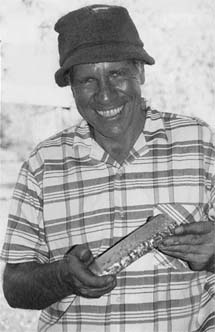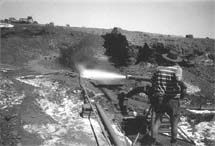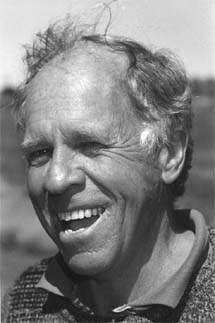Labour of Love
John Love is a man who enjoys what he
does because he does what he enjoys. If that isn't enough, he's found
his El Dorado too.
He tells us of his early days and life as a geologist
After I left school I didn't quite know
what to do but I was always very keen on geology so I decided on University
- it was a bloody hassle getting into Uni though. I did a course there
on Applied Geology, which is a cross between mining engineering and
geology.
During that time I had a student job at Mt Isa and when that finished
I hitched a ride on a truck which came through Tennant Creek on my way
back to Sydney. This was in the early sixties. I never knew Tennant
Creek existed or that anything like it did - it was pretty primitive
in those days.
We arrived in a big road train which dropped off a shipment of lime
at this little mine called Peko. I was fascinated by that, so the following
year I wrote to the Geology Section and was lucky to get work with Peko
Mine as a student geologist. I thought what a fascinating place.
After Uni I did a year with the Mines Department in N.S.W and then came
here and joined Geopeko. I was in the field for most of the time and
was underground geologist at Peko for about six months. This was great
as it showed me the insides of an underground mine and taught me to
think in three dimensions.
I began to think about ore bodies and the origins of rocks - it's a
fascinating geological story here in Tennant Creek. I was here was between
1966 and 1969 and then decided it was time to go overseas.
I resigned from Geopeko and went down to Sydney. I was about to get
on a boat to go to South Africa when I got a phone call from the Chief
Geologist here at the time and he asked if I'd do another job they had
in Tamworth, northern N.S.W. He said they had just got onto a scheelite
deposit, which is tungsten, and we'd explore that.
I thought, "Oh yeah, what's another few months?". So I went
up to Tamworth and worked on the Attunga scheelite deposit for about
six months or more. After a couple more small jobs I resigned again
and finally got away to South Africa.
I spent a year in South Africa working on the O'Okiep copper mines up
in the North West corner of South Africa in Namaqualand. That was also
fascinating, it was similar geology to here, except that the country
rock was high grade metamorphics and the copper bodies were in diorites
whereas here they're in the ironstone.
It was a real adventure, I was with totally different types of people
and apartheid was then in its hey day - it was a real shock to my system.
After twelve months there it was time to move on so I went to Rhodesia
to have a look round. I got a job for the first six months in a major
underground nickel mine, then I worked on a couple of gold mines where
they had gold in quartz. Coming from Tennant Creek, where I'd been used
to gold in ironstone, I didn't realise the value of gold in quartz.
I did a year there until I thought it was time to move on again.
I didn't know much about porphyry copper, which was a particular type
of low grade disseminated copper deposit that we hadn't then found in
Australia. One place they were found was in South America, so I hopped
on a plane and flew over to Argentina.
I then got the train across to Chile, over the mountains and across
the Andes - that itself was a fascinating experience and also being
thrown in the deep end without speaking any Spanish. At that stage Chile
was going through a pretty turbulent time. Allende had just got into
power and things were unstable.
I remember going over the border into Chile and the Chilean guards came
onto the train and I had to pay $10 a day for every day that I was in
Chile and I only had $50 left. I had to get a job within that time so
I thought I'd give it a go and I paid up my $50 which then allowed me
five days to get a job!
At that time no one who wasn't a Chilean were getting jobs. I went along
to the Embassy who gave me a few addresses and then went to what was
then the Geological Survey of Chile. I arrived on the door and said,
"How about a job?" I couldn't believe it when I got one!
I was in Chile for a year. I was first sent up to the Northern part
of Chile, up in the Atacama Desert and was working on porphyry coppers
there - large low grade copper deposits. That went on for six months
and about that time they had the coup, when Allende was deposed. It
was a very frightening experience. I'll never forget the several days
when we had to get back from the northern mountains and through several
road blocks, back to the city of Antofagasta.
I hid in a house there while they were shooting all around and the tanks
were rumbling up and down outside and the machine guns were chattering
away on the next corner. Helicopters were flying over and the search
lights were going. I'll never forget that.
A couple of days later the Army decided to flush out everyone and being
a 'Gringo', a non-Chilean person, it was pretty frightening. Luckily
on that particular day I thought that I must get word home to my parents,
so I went down to the Post Office and sent a telegram. It was just a
sheer fluke because while I was out, the Army went through the house
and if I had have been there I would have been caught up in goodness
knows what.
Anyway I survived and things got back to normal. I was then sent down
to the south end of Chile and worked on porphyry coppers again. That
was in the most beautiful country I'd ever been - mountains, ice and
snow - a bit like New Zealand except more so. By then, my year was up
and I thought it was time to move on again.
The next six months I spent touring around Europe and eastern Europe
with Michael Pepperday who used to be underground surveyor at Peko.
I'd been in contact with Geopeko back here in Australia. After Europe
I returned and rejoined them and spent three or four years over in the
West, exploring mostly up in the Pilbara area, around the then new Telfer
mine,
Peko went through a financial crisis in about 1979 and I decided that
it was time to go out of my own.
My aim was to find for myself a major deposit of either very fine grain
gold, which they'd been finding in Nevada at that stage, it was called
the Carlin deposit, or a scheelite deposit, like the Mittersill scheelite
deposit in Austria. I don't reckon anybody had really looked seriously
for either of those deposits. So I started out looking for them. I did
a lot of research in all the States then I set off in the field, following
up that research.
I started in N.S.W and went all over, trying to find these deposits.
I worked myself into Victoria and then all through South Australia,
all the time living in my vehicle which I had fitted out for camping
and prospecting. I then worked all the way through Western Australia.
There were several places where I found these deposits, or indications
of them, but everywhere I went I was hampered by the legal system of
Exploration Licences, where the big companies and others take up Exploration
Licences which cover vast areas of Australia. This ties up the ground
and no one can take any leases on that ground. Everywhere I went I was
frustrated by these Exploration Licences.
That saw me round to the Top End of the Northern Territory, to Darwin
and by that stage I was broke. Somehow or other I got into the sand
and gravel business in Darwin. Palmerston was just taking off then and
they wanted roads everywhere. I found out that I could peg an Extractive
Mineral Permit on sand or gravel without worrying about Exploration
Licences, so that was fantastic.
It opened up a whole new field for me and that kept me alive for many
years in the Darwin area, supplying sand and gravel to the Darwin industries.
Of course I never knew there was any difference between sand or gravel,
but in fact there are dozens of different types of sand and gravel!
It was great because it got me back on my feet again and it got me into
the industry and in about 1983 I started chasing gold again. The way
it happened was that I was on an Australasian Institute of Mining and
Metallurgy excursion which they have every year on the Queens Birthday
weekend in the Pine Creek area.
I was talking to a chap on that excursion and he told me that they used
to get gold out of the old uranium mines in the South Alligator River
area and that there used to be a battery out there. When that excursion
finished I went and had look at the mine and found where the old battery
was and found there wasn't any gold in it but then I went up to UDP
Falls.
Just on the side of the road there was an old tailings dam and it had
about 5000 tonnes in it. So I stopped the car and went and had a look
at it, took a couple of samples and panned them down in the South Alligator
River. To my utter amazement they were full of gold, it was just incredible!
That was in the then proposed Kakadu National Park and I couldn't peg
a lease on it but I knew under Section 178 of the Mining Act, you could
actually get an authority to mine it. So I applied for an authority.
I'll never forget the Mines Department officials just laughing at me,
saying I'd never mine those tailings, they were uranium tailings in
Kakadu National Park. Nevertheless after several years of bureaucracy
and all the rest of it, we did a deal with Pacific Gold Mines and they
actually set up a plant at Moline and transported the Moline and Rockole
tailings into that plant for processing. That gave me a bit of cash
and I was back on my feet again.
Following that was a fantastic couple of years for myself and my partner
Garry Hamilton, looking for gold and pegging leases. During that time
I always had in mind that the Eldorado tailings were here in Tennant
Creek. We did a deal with Peko, giving us the rights to mine these tailings.
That must have been in about 1987. Several years later we started mining
the tailings - some of the original battery sands were quite rich, two
or three grams per tonne.
We leached them for several years until 1994, during which time I also
scraped up and treated all those tailings that had accumulated down
the hill, one kilometre away on Joe Schmidt's land.
About that time, I and my partner decided there wasn't enough gold in
it for the both of us so we split up and he went to N.S.W and worked
on slate mines and that sort of thing and I've stayed here ever since.
After the sands finished I had 50,000 tonnes of slimes on the top of
the hill and I had to work out how to mine them.
I finally came up with a method whereby I shoot them down the hill with
a high pressure water cannon, with a trace of cyanide added, then pump
the tailings over the hill to my tailings dam. Every night I run the
solution through my carbon columns and extract the gold onto the carbon
and then periodically strip the carbon and extract the gold.
About a fortnight ago I finished the Eldorado tailings and now I've
commenced cleaning up. However I still have a couple of small dumps
to treat but they are very difficult because they are extremely fine
grained and high in copper, so I may be here for a while yet.
What makes a prospector?
Geologists do the research first and learn
all they can about an area. They'll go out and look at the rocks and
try and interpret what the rocks are trying to tell them and figure
out where the ore came from and where it is likely to be now.
They commonly take geo-chemical samples to send away for assay for things
like gold and other elements like copper, arsenic, tungsten etc, that
may occur with the gold. But the problem with this is that you've got
to pay to get the samples assayed and if you're taking a lot of them
it becomes a significant cost.
Of course it's easier for a geologist who's with a company and can afford
this then follow up with drilling. I couldn't afford this so I had to
go right back to basics and learn the old art of prospecting again.
I had to become a prospector like they were a hundred years ago. I learnt
to be able to detect minute amounts of gold, down to one part per billion,
in the pan. The gold had to be free gold but invariably if it out crops
on the surface, the rock weathers and the gold is released as tiny free
particles. I taught myself to pan, down to these incredible amounts,
which I suspect the assay laboratories then couldn't detect at those
levels. That was my main method of exploration.
I went to a place in Western Australia that was reputed to be a fine
gold (Carlin) deposit way out in the Gascoyne.
After speaking to the Geologist in charge, who said there was no visible
surface gold, I walked over the hill and took five samples from the
surface soil and panned them using my techniques and each one of them
had gold in it!
From that moment on I knew I could find a Carlin fine gold deposit if
it outcropped on the surface and from then on that was my main method
of exploration. It cost me nothing except effort and the water that
I'd carry with me. I reckoned doing that, as crude as it was, I could
still compete with the companies because I was actually there in the
field doing the work, not sitting in the office dreaming about it!
You just have to switch your eye in to look for that tiny, tiny speck,
it's almost microscopic, but when you get the sun on gold, it glints
like a piece of a jewel. It just needs that extra look to be able to
do it!


The old leach vat
used as a water reservoir.

Blasting away at the
tailings with the water cannon to put the tailings into solution.

The atomic spectrometer
measures the amount of gold in solution.
